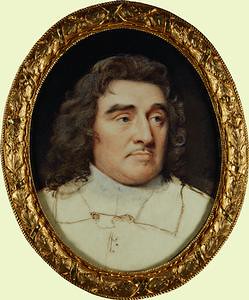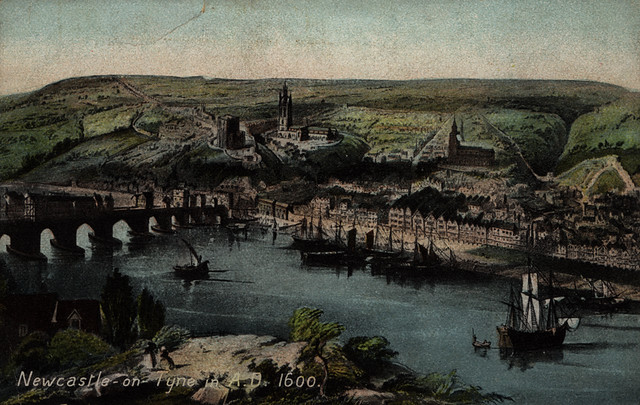George Monck, 1st Duke of Albemarle

-
Description
George Monck, 1st Duke of Albemarle, KG (6 December 1608 – 3 January 1670) was an English soldier and politician and a key figure in the restoration of Charles II. He was born at Potheridge, near Great Torrington, in Devon, second son of Sir Thomas Monck, a gentleman of a good Devon family but in straitened financial circumstances. Having assaulted the undersheriff of the county in revenge for a wrong done to his father, he was forced to go abroad. Becoming a soldier, he served as a volunteer in the expedition to Cádiz (1626), and the next year fought well at the siege of the Île de Ré (an abortive attempt to aid French Protestants in the city of La Rochelle). In 1629 Monck went to the Netherlands, then a centre of warfare, and there he gained a high reputation as a leader and a disciplinarian. In 1638 he threw up his commission in consequence of a quarrel with the civil authorities of Dordrecht, and returned to England. He obtained the lieutenant-colonelcy of Newport's regiment. During the operations on the Scottish border in the Bishops' Wars (1639–1640) he showed his skill and coolness in the dispositions by which he saved the English artillery at the Battle of Newburn (1640), though he had little ammunition. At the outbreak of the Irish rebellion (1641) Monck became colonel of Lord Leicester's regiment under the command of Ormonde. All the qualities for which he was noted through life—his talent of making himself indispensable, his imperturbable temper and his impenetrable secrecy—were fully displayed in this post. The governorship of Dublin stood vacant, and Leicester appointed Monck. Charles I, however, overruled the appointment in favour of Lord Lambart, and Monck with great shrewdness surrendered the appointment without protest. The Duke of Ormonde, however, viewed him with suspicion as one of two officers who refused to take the oath to support the Royal cause in England, and sent him under guard to Bristol. Monck justified himself to Charles in person, and his astute criticisms of the conduct of the Irish war impressed the king, who gave him a command in the army brought over from Ireland during the English Civil War. Taken prisoner by the Roundheads at the Battle of Nantwich in 1644, he spent the next two years in the Tower. He spent his imprisonment writing his Observations on Military and Political Affairs. Monck's experience in Ireland, however, led to his release. He was made major general in the army sent by parliament against the Irish rebels. Making a distinction like other soldiers of the time[1] between fighting the Irish and taking arms against the king, he accepted the offer and swore loyalty to the parliamentary cause. He made little headway against the Irish and concluded an armistice (called then a "convention") with the rebel leaders upon terms which he knew the parliament would not ratify[2]. The convention was indeed a military expedient to deal with a military necessity, and although most of his army went over to the Royalist cause, he himself remained faithful to his employers and returned to England. Although parliament, as expected, disavowed the terms of the truce, no blame was attached to Monck's recognition of military necessity. He next fought at Oliver Cromwell's side in Scotland at the Battle of Dunbar, a resounding victory. Made commander-in-chief in Scotland by Cromwell, Monck completed the subjugation of the country. In February 1652 Monck left Scotland to recover his broken health at Bath, and in November of the same year he became a general at sea in the First Anglo-Dutch War, which ended in a decisive victory for the Commonwealth's fleet and marked the beginning of England's climb to supremacy over the Dutch at sea. On his return to shore Monck married Anne Radford (nee Clarges). Next year he returned to Scotland, methodically beating down a Royalist insurrection in the Highlands. At Cromwell's request, Monck remained in Scotland as governor. In 1654, the timely discovery of a plot fomented by Robert Overton, his second in command, gave Monck an excuse for purging his army of all dissident religious elements, then called "enthusiasts", deemed "dangerous" to the Cromwell regime. In 1655 Monck received a letter from Charles II, a copy of which he at once sent to Cromwell, who is said to have written to him in 1657: "There be [those] that tell me that there is a certain cunning fellow in Scotland called George Monck, who is said to lye in wait there to introduce Charles Stuart; I pray you, use your diligence to apprehend him, and send him up to me." Monck's personal relations with Cromwell were those of sincere friendship on both sides. During the confusion which followed Cromwell's death on 3 September 1658, Monck remained silent and watchful at Edinburgh, careful only to secure his hold on his troops. At first he contemplated armed support of Richard Cromwell, but on realising the young man's incapacity for government, he gave up this idea and renewed his waiting policy. In July 1659 direct and tempting proposals were again made to him by the king. Monck's brother Nicholas, a clergyman, brought to him the substance of Charles's letter. He bade his brother go back to his books, and refused to entertain any proposal. No bribe could induce him to act one moment before the right time. That right time came when Gen. John Lambert declared against the Rump Parliament. On 23 October 1659, Monck at once took measures of active opposition against this move. Holding Lambert in play without fighting until Lambert's army began to melt away for want of pay, Monck received the commission of commander-in-chief of the parliamentary forces on 24 November 1659. He entered the capital on 3 February 1660. In all this his ultimate purpose remained mysterious. At one moment he secretly encouraged the demands of the Royalist City of London, at another he urged submission to the existing parliament, then again he refused to swear an oath abjuring the house of Stuart, and further he hinted to the Rump of the Long Parliament the urgent necessity of a dissolution. He forced the dissolution of the Rump Parliament, while at the same time breaking up, as a matter affecting discipline, the political camarillas that had formed in his own regiments. He was now master of the situation. Though he protested his adherence to republican principles, it was a matter of common knowledge that the new parliament would have a strong Royalist colour. Monck himself, now in communication with Charles II, accepted the latter's Declaration of Breda, which was largely based on Monck's recommendations. The new parliament met on 25 April 1660, and on 1 May voted the restoration of the monarchy. Soldier though he was, he had played the difficult game of politics in a fluid and uncertain situation with incomparable skill. That he was victor sine sanguine, i.e., "without blood", as the preamble of his patent of nobility stated, was generally applauded as the greatest service of all, especially after the violence of the Civil Wars. Charles II rewarded Monck suitably for his services in restoring him to his throne. He was knighted, invested with the Order of the Garter, and made Master of the Horse in the King's household. Charles also raised him to the Peerage as Duke of Albemarle, Earl of Torrington, in the County of Devon, Baron Monck, of Potheridge in the County of Devon, Baron Beauchamp, of Beauchamp in the County of Devon, and Baron of Teyes, in the County of Devon, and he received a pension of £700 a year. He entirely concurred in the disbandment of the New Model Army, and only the regiment of which he was colonel, the Coldstream (Guards), survives to this day, one of the oldest military formations in the world and the last representing the army of the English Civil War. As a further token of Charles II's gratitude, in 1663 Albemarle was named one of eight Lords Proprietors given title to a huge tract of land in North America which became the Province of Carolina, the present-day American states of North and South Carolina. The town of Moncks Corner, South Carolina is named after him. His last military services to England were rendered in the Second Anglo-Dutch War when he was appointed commander-in-chief of the English fleet. [3] After that war's dismal conclusion,[4] he returned to private life (although he officially served as First Lord of the Treasury). He died of oedema on 3 January 1670, "like a Roman general with all his officers about him".[citation needed] He is buried in Westminster Abbey. His titles were inherited by his only son, Christopher, Earl of Torrington (1653–1688), on whose death they became extinct. -
Owner
lisby1 -
Source
Flickr (Flickr) -
License
What does this mean? Public Domain Mark
-
Further information
Link: https://www.flickr.com/photos/60861613@N00/3969618335/
Resource type: Image
Added by: Simon Cotterill
Last modified: 8 years, 5 months ago
Viewed: 1754 times
Picture Taken: Unknown -
Co-Curate tags







